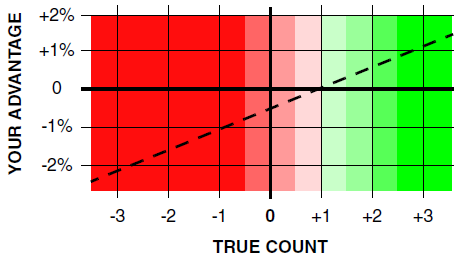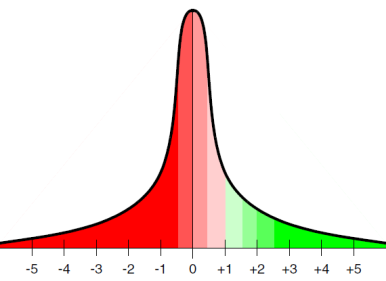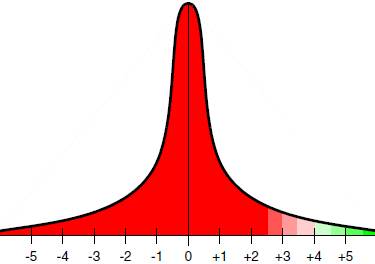Does Blackjack Card Counting Really Work?
Yes, it really works, but winning is slow and risky
Blackjack card counting really works! You win by betting more when the remaining deck is favorable, and less when it is unfavorable, allowing you to gain an overall advantage and win in the long run. However, for practical purposes, card counting doesn't work because you need to risk huge amounts to win just a little.
Watch the YouTube video of this web page
How does card counting work?
How do you "count" the cards?
Why are certain cards "good" and "bad"?
How do you use the count?
What is the "true" count?
How much is your advantage or disadvantage as the count varies?
How often is the count favorable?
How risky is card counting?
Is the card counting shown in the movies realistic?
Do casinos let card counters win?
How difficult is card counting?
Does card counting work with 6 decks?
Does card counting work with continuously shuffling machines (CSMs)?
Does card counting work with online casinos?
Recommendations
Basic Strategies: Perfect and Simplified
How does card counting work?
As the cards are dealt out, the composition of the remaining cards changes. Having more "good" cards and fewer "bad" cards remaining in the deck is more favorable for the player. When the remaining deck is good enough to give you an advantage, you bet more. At other times, you bet less or stop playing.
How do you "count" the cards?
There are various types of card-counting strategies. I'll describe the simplest and most popular one, often called the "high-low" strategy. You only need to keep track of one number, the "running count," which starts with 0 for a freshly shuffled deck. Each card has a point value:
Bad cards Medium Good cards
2 3 4 5 6 7 8 9 10 J K Q A
1 1 1 1 1 0 0 0 -1 -1 -1 -1 -1
The low cards 2 through 6 have a value of +1. The high cards, 10 through Ace, have a value of -1. The cards in the middle have a value of 0. You can see that the numbers of good and bad cards are balanced.
As each card is dealt out and revealed, you add 1, 0, or -1 to the running count. The starting count, average count, and ending count are all zero. But any mismatch between low and high cards dealt out causes the running count to fluctuate around zero. A positive count means extra "bad cards" have been used up, and extra"good cards" remain in the deck, which is favorable for future hands. A negative count means the opposite.
Why are certain cards "good" and "bad"?
You might wonder why high cards are "good" and low cards are "bad." Cards that are good for the player are good for the dealer too, right? Not exactly. There are some player advantages that are enhanced when "good" cards are plentiful and "bad" cards are lacking:
- An abundance Aces and 10s means more blackjacks. This is good because when you get a blackjack, you win one and one-half bets; when the dealer gets a blackjack, you lose only one bet.
- When both you and the dealer have a bad hand, you can stand on yours; the dealer must hit, and maybe bust. In this situation, the dealer is even more likely to bust with many 10s remaining.
- When it's to your advantage, you can double down on 10 or 11; the dealer cannot. Many 10s remaining in the deck increases your chances of making a good hand with your one hit card.
How do you use the count?
When the count becomes high enough to overcome the house advantage, you increase your bet. The stronger your advantage, the more you bet. When you have a disadvantage, you decrease your bet or stop playing. Also, you can modify a few marginal playing decisions based on the count.
What is the "true" count?
To get the best advantage of the knowing the running count, you need to determine what's called the "true" count, which adjusts the effects for the number of remaining decks. For example, 1 low card removed from a single deck is enough to offset the dealer advantage and get an even game; this is called a "true" count of +1.
To get the same effect from a 6-deck game, proportion-wise, you need to remove 1 low card from each of the 6 decks, or a total of 6 low cards. This is a running count of +6, which is the same as a true count of +1.
In general, the true count is the running count divided by the number of decks remaining. For example, in a 6-deck game, with 1 deck used and 5 decks remaining, when running count is +10, the true count is +10 divided by 5, or +2 (which is equivalent to removing 2 small cards from a single deck).
How much is your advantage or disadvantage as the count varies?
The following graph shows you how your overall advantage or disadvantage changes with the true count. (This is for a typical Las Vegas blackjack game: six decks, dealer hits soft 17, doubling allowed on any two cards, no surrender, and blackjack pays 3:2.)
Looking at the graph, you can see that with a count of zero, which is the average count, you have an average loss of one-half of 1%. A true count of +1 is enough to offset the dealer advantage and give you a fair game -- no win or loss on average. You need a true count of +2 to have an advantage of one-half of 1%. To get as much as a 1% advantage, you need a true count of +3.
How often is the count favorable?
The count is not favorable very often, as shown in the following graph. The red area represents the losing times and the green zone the winning times. The average count is zero, and most of the time the count is close to zero, where you play at a slight disadvantage. You need a true count of at least +1 to overcome the built-in house edge.
About 15% of the time you're in the green zone, and the count is good enough that you can make some profitable bets. For example, when the true count is +2, you have an advantage of one-half of 1%. You need to bet much more during these favorable times to make up for losses during the other 85% of the time. When the count goes deeply negative, you're playing at a strong disadvantage, which is a good time to quit or take a restroom break.
How risky is card counting?
Card counting is very risky. When you have an advantage, it is typically in the neighborhood of one-half of 1%. In this situation, you need to risk $100 on a hand to win 50 cents on average. On any particular $100 hand, you'll never earn exactly 50 cents. You will either:
Winning $100 or $200 or "pushing" is not a problem, but can you afford to lose $100 or $200 in an attempt to earn 50 cents? And can you afford a 10-bet losing streak ($1,000)? Streaks like this definitely happen. You'll also have big winning streaks, but you can't count on them happening at any particular time. One big losing streak can easily be followed by another.
- Win $100 (or maybe $200 if you double down or split)
- Lose $100 (or maybe $200 if you double down or split)
- Tie ("Push")
Why you need a $10,000 bankroll to win $10 per hour (video)
Is the card counting shown in movies realistic?
In movies like Rain Man and 21, card counters win like crazy, which is nothing like real life. Real card counters have a tiny advantage -- they win, they lose, they break even, just like everyone else. Their tiny gains, over weeks or months, are obscured by relatively large winning and losing streaks.
To win $5 or $10 per hour card counting, you need make bets of $100 and more, and experience winning and losing streaks in the thousands. If losing $1000 or $2000 would upset you or cause financial hardship, then card counting is not for you. On the other hand, if you can afford to risk that much, you're probably not much interested in earning what amounts to the minimum wage.
If you want to do card counting, it should be for the entertainment value. It's not a good way to make money.
Do casinos let card counters win?
Card counting is legal, but casinos can turn away or expel anyone, for any reason. They closely watch players who vary their bets by large amounts or jump in and out of games, so card counters must disguise their play to avoid getting kicked out. Dealers always shuffle well before the cards are used up, destroying the most favorable situations.
And finally, casinos can impose unfavorable rules, like a 6:5 payoff for blackjacks instead of the usual 3:2, which ruins the odds for everyone, not just card counters. You can see in the following graph that everyone plays deep in negative zone practically all the time, losing 2% on average.
Average loss of 2% with 6:5 blackjack payoff
How difficult is card counting?
Card counting does not require unusual talent or intelligence -- anyone can do it. However, it takes many months of memorizing and practice to become proficient. There are three basic learning steps:
- Learn the "basic strategy," without card counting. This means memorizing the best action to take for every combination of player total and dealer's up card. You need to know this well enough to act without even thinking about it.
- Learn how to count cards, keep track of the count, and modify your betting based on the count. With the addition of this skill, you can play with an advantage.
- To gain the maximum advantage, you can also learn how to modify the basic strategy decisions in a few marginal situations, based on the count. For example, when you get the worst possible hand, 16 vs. a dealer 10, it is slightly better to stand with many 10s left in the deck, and slightly better to hit with many low cards left in the deck.
Does card counting work with 6 decks?
Yes. Card-counting is just as easy for 6 decks as for a single deck. However, 6-deck games have a slightly worse house edge than single-deck or double-deck games with the same playing rules, which makes profitable situations less common and cuts your long-term win rate.
Does card counting work with continuously shuffling machines (CSMs)?
No. Continuous shuffling machines effectively perform a complete shuffle every time the dealer feeds the used cards into the machine. The count is effectively zero all the time, so you never have an advantage.
Does card counting work with online casinos?
No. All online casinos perform a shuffle after every round. It's like playing against a freshly shuffled deck every hand. The count is always zero when you place your bet.
Recommendations
- Don't gamble if you're prone to compulsive behavior. Some people get addicted, which is a serious problem
- Don't play 6:5 blackjack games. You can almost always find a full-pay game nearby.
- Risk only what you can afford.
- Gamble only for as long as you're having a good time. Whether you're winning or losing, stop when you have negative feelings like anger, fear, or despair.
- Be prepared for losing streaks, which will definitely happen, card counting or not.
- Learn a basic strategy first, and practice using it for real in the casino, before you try card counting.
Basic Strategies: Perfect and Simplified
The "basic strategy" is the set of actions that give you the best possible return, based on your total and the dealer's visible "up card," without knowing anything about the composition of the remaining deck. For a given set of playing rules, there is only one best action for each possible situation.
Most websites and books teach the perfect basic strategy, which is really good, but it takes weeks of study and practice to become proficient. Why not learn a simplified strategy instead, which is faster and easier, and nearly as good? The following chart shows you the details.
| Strategy |
Effort to learn |
Bet size |
Average session* |
Typical session* |
| Super-Easy | 1 hour |
$10 |
lose $11 |
lose $130 or win $120 |
| Simple | 1 day |
$10 |
lose $8 |
lose $130 or win $120 |
| Great | 1 week |
$10 | lose $7 |
lose $125 or win $120 |
| Perfect basic |
1 month |
$10 | lose $6 |
lose $125 or win $120 |
| Card counting |
1 year |
$10-$100 | win $5 |
lose $500 or win $505 |
* A "session" is 100 hands, about an hour of play.
For more information about the simplified strategies, go to BlackjackCalculation.com
For a good introduction to blackjack, go to the Wizard of Odds web site
For a very good and free online book on blackjack, see Modern Blackjack, An Illustrated Guide to Blackjack Advantage Play, by Norman Wattenberger




